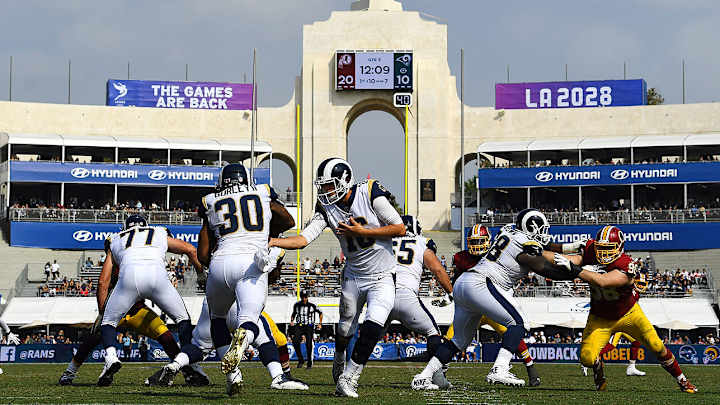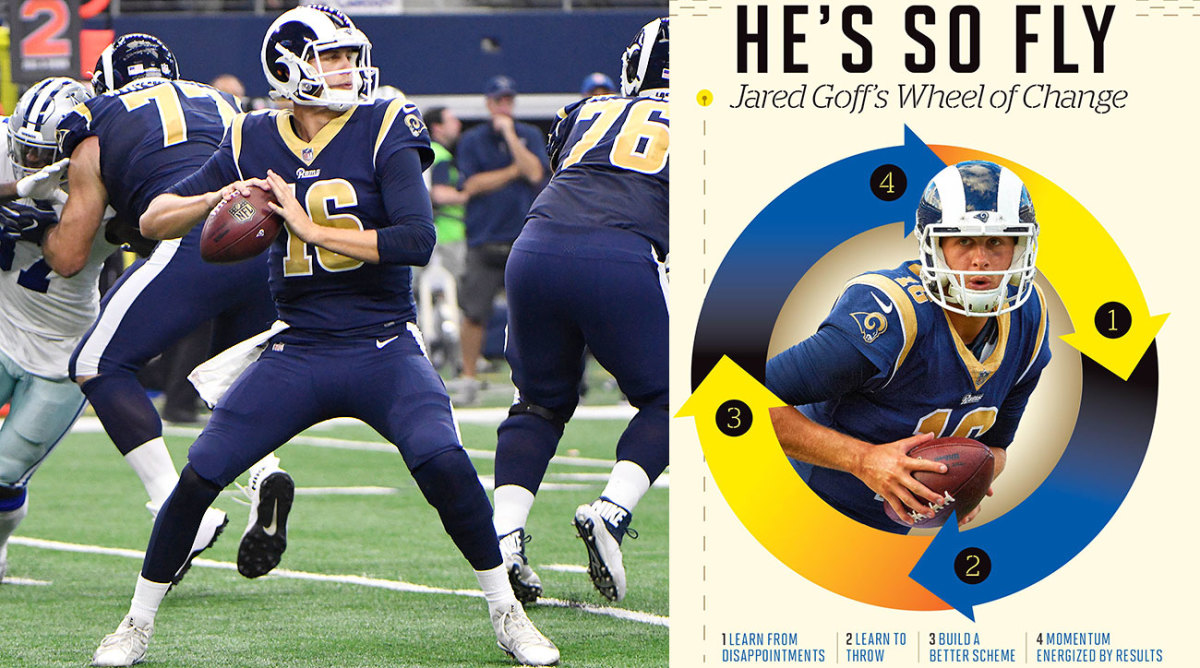Jared Goff Is Thriving at the Center of Les Snead’s Two-Phase Plan

Les Snead is the rare NFL general manager with a bicycle mounted on a trainer in the middle of his office. His immobilized Schwinn—sleek, white, decorated with stickers—appears stolen from a SoulCycle class, and its handlebars curl like ram horns toward a television mounted on the wall. That way Snead, 46, can get all Tour de France-y and watch film.
And whereas Snead might view the velocipede as a vehicle on which to multitask, a more cynical observer could find a metaphor here for the GM’s tenure. Since arriving in 2012, none of the teams he has assembled have won more than seven games, despite constant roster churn—the NFL equivalent of pedaling furiously and not going anywhere. This season, though, the Rams are 5–2 and riding atop the NFC West (with the tougher half of their schedule approaching) because of a two-part plan that Snead started in the spring of ’16, hoping to catapult a team returning to Los Angeles from St. Louis, the franchise at once going big and going home.
At the center of his strategy—because, duh, this is the NFL—was a quarterback. Phase 1 began in April 2016 when Snead made a calculated bet, trading six draft picks to obtain the No. 1 selection, which he used to grab Cal junior Jared Goff. The QB possessed a strong arm, a dream body type . . . and almost no experience running a pro-style offense. The ensuing NFL season unfolded about as well as could be expected. The Rams went 4–12, finishing with seven straight losses in Goff starts.
Phase 2 started this spring, with Snead’s laying out four goals, the first three of which concentrated on enhancing everything around his new QB: 1) Hire a new coach (after Jeff Fisher was fired last December); 2) review and perfect all processes, from meeting schedules to sleep patterns to organizational philosophies; 3) improve the offense; and 4) don’t forget about the defense!
Snead accomplished No. 1 quickly, stealing offensive prodigy Sean McVay from Washington last January. He hired Mike Forde, a high-performance consultant who was once Chelsea’s director of football operations, to calibrate the Rams’ approach to just about everything. (No. 2: check.) Then he added a left tackle, Andrew Whitworth; a center, John Sullivan; and three wideouts: Sammy Watkins, Robert Woods and third-round draft pick Cooper Kupp. (No. 3: check. As for No. 4, Aaron Donald is back on the field: good enough.)
The Rams did all this because they had to, because that’s how NFL teams win. Think of the QBs who defined this generation: Peyton Manning, Tom Brady, Drew Brees, Aaron Rodgers, Ben Roethlisberger. . . . They didn’t win on spirals alone. They were buttressed by teammates acquired specifically to help them, and they ran offenses tailored to their strengths. Brady isn’t Brady without Bill Belichick, the system he created around his QB and the teammates he obtained and improved. Now think of the next crop of promising passers: Goff, Winston, Mariota, Wentz, Watson. . . . Plenty of talent, sure, but each one lacks the infrastructure enjoyed by the likes of Brady and Rodgers. How those young guys develop—and how their organizations develop around them—will define football’s next generation.
Goff’s successful transformation appeared unlikely as he was yanked in the fourth quarter of the season finale, a 44–6 loss to the Cardinals. But the forces at work in the QB’s development crystallized for Snead this summer, when he received what he says was “the best birthday present” of his life. The GM’s wife, Kara, took him to Boulder, Colo., to meet with author Jim Collins, who writes about something he calls the Flywheel Effect: combinations of factors that work together to move companies from “good to great,” like a massive metal disk being propelled forward by momentum.
Every Flywheel is different, with varying factors influencing it. For this particular business, a football team, imagine a clock with different elements at noon, three, six and nine, with arrows connecting one element to the next in a circle, all working together, building momentum. Snead filled an entire legal pad with notes, beginning to imagine the Rams’ organization as a Flywheel. The hub? Goff. “Best six hours of my life,” he says, before realizing how that might sound to his wife and children.
He corrects this assessment. “Top 10 life moment,” he says—with the potential to climb.

1. Learn From Disappointments
As the 2016 NFL draft approached, Snead figured that the Titans, who held the top pick and had selected Marcus Mariota the year before, would be amenable to a trade. Having cycled through the likes of Shaun Hill and Austin Davis in the previous 48 games, Snead desperately needed a franchise passer, and he liked both Goff and North Dakota State’s Carson Wentz, who evoked a young Brett Favre.
The Rams visited Wentz first, and he had an impressive workout in perfect conditions—sunny, no wind—in Fargo. Snead and Co. then flew to the Bay Area, where on the night before a scheduled morning session with Goff they saw that rain was threatening their plans. The quarterback met Snead in the lobby of his Berkeley hotel, and the GM mentioned a few pockets of time the next day when it appeared the rain might abate. “We’re going at 8:30 a.m.,” Goff said. “And I hope it rains.”
The skies indeed opened that morning, but the workout went off as scheduled, and that was that. The Rams had found themselves a QB, and Snead saw for the first time how hard it was to rattle Jared Goff.
Rain was one thing. The debacle of 2016 was another. The five previous quarterbacks taken with the No. 1 pick—-Matthew Stafford, Sam Bradford, Cam Newton, Andrew Luck and Jameis Winston—each started his team’s season opener as a rookie. Early in his debut year, Goff did everything except play. He moved from Berkeley to Oxnard (for minicamps) to Irvine (for training camp) to Thousand Oaks (for the season). He sequestered himself, living alone so he could immerse himself in football. He learned a new offense and how to play under center, after years in the shotgun. He saw his competition (starter Case Keenum) benched and his coach fired.
His first start finally came on Nov. 20, against the Dolphins. It rained again, but Goff didn’t turn the ball over in an otherwise unremarkable debut. Still, the Rams lost, and then they lost six more, as Goff was sacked 26 times, compiling the lowest QBR (22.2) of anyone who started at least five games. He’d asked for rain and gotten it.
Still, Snead saw signs that he had put the right guy in the center of his Flywheel. Some of Goff’s throws—deep balls, passes into tight windows . . . and that zip!—made the GM’s heart palpitate. More important, the young quarterback never blamed his porous offensive line or the running game that moved like a car stripped of its tires. And he fought when only pride mattered. Late in one game, down 21 to the Seahawks in mid-December, he took off for the end zone and dropped a shoulder at cornerback Richard Sherman. Nearly decapitated, Goff still tried to wave off team doctors. “We already knew he could throw the football,” Snead says, “but I saw something that day under the California cool that made me say, Wow, it’s there.”
Not many shared Snead’s optimism. Fans mocked Goff and Snead across social media, a reaction the GM describes as “probably quick-triggered”—but “that’s the microwave world we live in.” Goff remained nonplussed. “Twitter doesn’t bother me,” he says. “When people that have never played the game have opinions, it doesn’t make a difference. It’s just a bunch of ignorance. In person, people are too scared [to say something].”
The QB refused to be deterred, in part because he remained vaguely aware that, years before, his own father’s professional baseball career had suffered from self-imposed pressure. In Jerry Goff’s last game in the majors, playing catcher for the Astros in 1996, he knew Houston’s front office doubted him and, confidence evaporating, he gave up six passed balls.
Twenty years later, father watched son suffer all those sacks and wondered whether his kid might end up like David Carr, the No. 1 pick in 2002, who was sacked out of the NFL. Instead, Jared found the calm his dad never did. “I was pretty hard on myself if I didn’t play well, and there were times that it affected my play,” Jerry says. “Jared and I are opposites in that regard.”
2. Learn To Throw
When the season ended, Goff needed distance—from football, physical pain, celebrity, chaos. He decamped to Cabo San Lucas in Mexico with his four best friends, a group known (to themselves, anyway) as the Fab Five. The Five had been childhood buddies who played sports; now they’re a consultant, an Arizona grad student working toward an MBA, a property manager, a budding NFL quarterback and his new (and unemployed) roommate. They spend most days on a group text-message thread, lobbing inside jokes back and forth.
In Mexico, Goff forgot about his unremarkable rookie season. He roamed the beach unnoticed, sipped blended beverages, lounged around his hotel pool and rode a banana boat. It was his first (semi)adult vacation.
Mind cleared, body healed, he flew back to the U.S. and hired Adam Dedeaux, a mechanics guru for what seems like half of the NFL’s passers. Goff provided a counterpoint to established stars like Brady and Matt Ryan, who visit Dedeaux in Southern California to refine their skills. For all the success Goff had in college and at Marin Catholic High, he’d never really put the microscope to his throwing motion. He didn’t need an overhaul, necessarily, but he required significant changes. For as hard and as far as he could throw, he lacked the basic foundation for NFL longevity: a consistent, repeatable motion.
Goff visited Dedeaux more than 30 times this offseason, undergoing physical and psychological assessments and making major alterations to the one thing he’d done best his entire life: throw. He focused on footwork, on driving passes with his body rather than with his arm to create torque, on generating power and efficiency by shortening his motion. Sometimes, as passes whistled by, Dedeaux thought, Oh, yeah, that’s the No. 1 pick.
On July 4, the Fab Five rented a house in Newport Beach and played two-on-two touch football on the sand before the sun dropped and the fireworks exploded. Goff was the all-time quarterback, naturally, and Patrick Conroy (the new roommate) says he noticed a glow of inner peace.
“His energy was noticeably different this offseason,” says Jared’s sister, Lauren. “He seemed more at ease.” The Rams’ Flywheel was starting to budge.
3. Build a Better Scheme
As part of his job interview last winter, McVay met with Goff at the Rams’ offices in Thousand Oaks. The two spoke for maybe half an hour. The coach wanted to know how his prospective QB had processed the fiasco of 2016. Did he blame the coaches? Did he demeaningly refer to the Rams’ old scheme as a “middle school offense,” the way running back Todd Gurley had last December?
“He took accountability, didn’t make any excuses,” McVay says. “He struck me as unfazed.”
Goff, in turn, wanted to know what McVay had done in Washington to turn Kirk Cousins into a starter worthy of consecutive franchise tags. The coach explained his usual approach, that he’d designed schemes around his quarterback and his particular strengths. He told Goff he would study him and mold the Rams’ offense around what he did best, accounting too for his teammates’ talents (Watkins’s speed, for example, and Gurley’s shiftiness). Goff texted his father immediately afterward. “He was ecstatic,” says Jerry.
McVay—now 31, he was the youngest NFL head coach ever hired—and his 23-year-old QB aren’t so far apart in age, but they don’t bond over Goff’s favorite pop artists, like Justin Bieber. Their relationship is built entirely around offensive football and only offensive football. They meet daily to go over plays and brainstorm strategy, two blond millennial bros who should be out enjoying the SoCal celebrity circuit.
Goff believes his new coach has held true to the philosophy he espoused in that initial meeting. McVay revamped the core of L.A.’s offense, which now mixes elements from the Patriots (heavy presnap motion), Falcons (outside runs) and Saints (downfield route combinations) with Goff-specific alterations. McVay tossed out the conservative Rams offense, which ranked last in the NFL in each of the past two years, incorporating more play-action, bootlegs and deep passes—all strengths that Goff refined with Dedeaux this spring.
“Jared’s not limited in anything,” McVay says.
“He’s very creative, super player-driven,” Goff says of his coach.
When Dedeaux looks at the offense, he sees a system adapted to its quarterback—not, as is more often the case, a quarterback adapting to a system. He calls McVay a “genius” and labels his approach “rare.”
“What people need to understand is how much a coach impacts his quarterbacks,” says 77-year-old Roman Gabriel, who threw 201 touchdowns in 16 seasons with the Rams and Eagles. “Goff took more shots than he had to [last year] because the design of that offense wasn’t conducive to a young quarterback being good. The style of offense Sean brought is more conducive to the kind of quarterback Goff is.”
4. Momentum Energized By Results
Back in the office, beside his bicycle, Snead grabs his iPhone and dials up someone listed as ‘Sprint’ in his contacts. That’s Kara, his wife.
The Rams, at this point, are five games into the 2017 season. Their Flywheel is spinning, with roster additions blocking for and catching passes from an improved quarterback on newly designed plays. Momentum is building. Goff decimated the Colts for 306 passing yards in the opener, tossed three TDs against the 49ers in Week 3 and pulled off a comeback win at Dallas in Week 4. Through fives games L.A. scored 142 total points, third most under a first-year coach in the modern era. (In the subsequent weeks they will edge out the Jaguars 27–17 in the Revelation Bowl and hammer the Cardinals 33–0 in London.)
“This season is a derivative of our Flywheel,” Snead says as Kara picks up, on speakerphone. “What’s that foreword you had me read last night?” he asks.
“Malcolm Gladwell,” she responds. “From The Person and the Situation.”
“I [read it to mean] this,” he says. “It’s absurd to try to figure out the difference between Manning and Favre. To the naked eye, there’s not a huge difference. What’s probably the biggest variable is the situation they’re in.”
“That would be a perfect way to look at Jared,” Kara says. “The difference in his development between this year and last year: He’s playing well, he’s in a great situation.”
Snead nods and smiles as his better half gives voice to his thoughts. The Rams are no longer riding in place. Everything around Goff has changed: his teammates, his offensive scheme—he’s even altered his throwing mechanics. In order to elevate his QB from good to great, says Snead, “I have a sneaky suspicion that it takes all those things.” The Rams’ Flywheel is in full motion.
